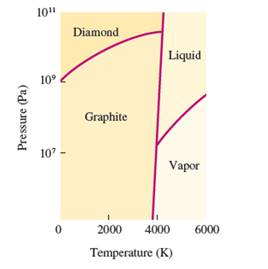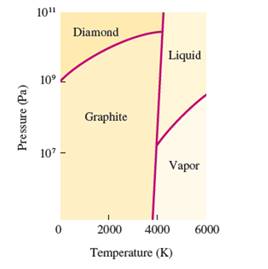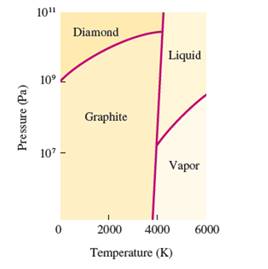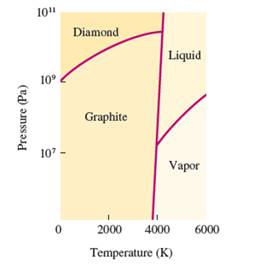
(a)
Interpretation: The number of triple points in the given phase diagram of carbon needs to be determined.

Concept Introduction:
The conversion of
The heating -cooling curve is the curve of temperature v/s time that interpret the change in the states of matter with increase in temperature.
Freezing point is the temperature at which the solid state converts to liquid state or vice-versa. Boiling point is the temperature at which the liquid and gas state reach to an equilibrium hence after this temperature, both states must be in equilibrium.
(b)
Interpretation: The phases which coexist at the triple points in the given phase diagram of carbon needs to be determined.

Concept Introduction:
The conversion of solid to liquid and gas involves the change in temperature that can display in heat curve.
The heating -cooling curve is the curve of temperature v/s time that interpret the change in the states of matter with increase in temperature.
Freezing point is the temperature at which the solid state converts to liquid state or vice-versa. Boiling point is the temperature at which the liquid and gas state reach to an equilibrium hence after this temperature, both states must be in equilibrium.
(c)
Interpretation: The change when graphite is subjected at very high pressure at room temperature needs to be explained.

Concept Introduction:
The conversion of solid to liquid and gas involves the change in temperature that can display in heat curve.
The heating -cooling curve is the curve of temperature v/s time that interpret the change in the states of matter with increase in temperature.
Freezing point is the temperature at which the solid state converts to liquid state or vice-versa. Boiling point is the temperature at which the liquid and gas state reach to an equilibrium hence after this temperature, both states must be in equilibrium.
(d)
Interpretation: The denser state out of graphite and diamond needs to be determined, if the density increases with increasing the pressure.

Concept Introduction:
The conversion of solid to liquid and gas involves the change in temperature that can display in heat curve.
The heating -cooling curve is the curve of temperature v/s time that interpret the change in the states of matter with increase in temperature.
Freezing point is the temperature at which the solid state converts to liquid state or vice-versa. Boiling point is the temperature at which the liquid and gas state reach to an equilibrium hence after this temperature, both states must be in equilibrium.
Want to see the full answer?
Check out a sample textbook solution
Chapter 16 Solutions
EBK WEBASSIGN FOR ZUMDAHL'S CHEMICAL PR
- Can I please get help with identifying these?arrow_forward4. Calculate the pH of a 0.10 M acetic acid (CH3COOH) solution if the Ka of acetic acid = 1.8 x 10-5arrow_forwardDraw the Zaitsev product of the dehydration of this alcohol. + I X 5 OH ざ~ TSOH Click and drag to start drawing a structure.arrow_forward
- Please help with identifying these.arrow_forwardFor the reaction: CO2(g) + H2(g) --> CO (g) + H2O (g) Kc= 0.64 at 900 degrees celcius. if initially you start with 1.00 atmoshpere of carbon dioxide and 1 atmoshpere of hydrogen gas, what are the equilibrium partial pressuses of all species.arrow_forwardCan I please get this answered? With the correct number of significant digits.arrow_forward
- Draw the Hofmann product of the dehydroiodination of this alkyl iodide. ☐ : + Explanation Check esc F1 2 3 I 88 % 5 F5 I. X © tBuOK Click and drag to sta drawing a structure. © 2025 McGraw Hill LLC. All Rights Reserved. Te BI BB F6 W E R Y S H Karrow_forwardCan I please get help with this graph, if you could show exactly where it needs to pass through please.arrow_forwardDraw the condensed structure of 1,3-dihydroxy-2-pentanone. Explanation Check Click anywhere to draw the first atom of your structure. Х C © 2025 McGraw Hill LLC. All Rights Reserved. Terms of use +arrow_forward
 ChemistryChemistryISBN:9781305957404Author:Steven S. Zumdahl, Susan A. Zumdahl, Donald J. DeCostePublisher:Cengage Learning
ChemistryChemistryISBN:9781305957404Author:Steven S. Zumdahl, Susan A. Zumdahl, Donald J. DeCostePublisher:Cengage Learning Chemistry: An Atoms First ApproachChemistryISBN:9781305079243Author:Steven S. Zumdahl, Susan A. ZumdahlPublisher:Cengage Learning
Chemistry: An Atoms First ApproachChemistryISBN:9781305079243Author:Steven S. Zumdahl, Susan A. ZumdahlPublisher:Cengage Learning
 Chemistry for Engineering StudentsChemistryISBN:9781337398909Author:Lawrence S. Brown, Tom HolmePublisher:Cengage Learning
Chemistry for Engineering StudentsChemistryISBN:9781337398909Author:Lawrence S. Brown, Tom HolmePublisher:Cengage Learning Chemistry: Principles and PracticeChemistryISBN:9780534420123Author:Daniel L. Reger, Scott R. Goode, David W. Ball, Edward MercerPublisher:Cengage Learning
Chemistry: Principles and PracticeChemistryISBN:9780534420123Author:Daniel L. Reger, Scott R. Goode, David W. Ball, Edward MercerPublisher:Cengage Learning Chemistry: Principles and ReactionsChemistryISBN:9781305079373Author:William L. Masterton, Cecile N. HurleyPublisher:Cengage Learning
Chemistry: Principles and ReactionsChemistryISBN:9781305079373Author:William L. Masterton, Cecile N. HurleyPublisher:Cengage Learning





